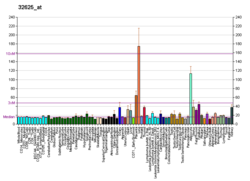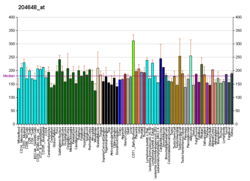| NPR1 |
|---|
|
| Identifiers |
|---|
| Aliases | NPR1, ANPRA, ANPa, GUC2A, GUCY2A, NPRA, natriuretic peptide receptor 1 |
|---|
| External IDs | OMIM: 108960; MGI: 97371; HomoloGene: 37367; GeneCards: NPR1; OMA:NPR1 - orthologs |
|---|
| Gene location (Human) |
|---|
 | | Chr. | Chromosome 1 (human)[1] |
|---|
| | Band | 1q21.3 | Start | 153,678,688 bp[1] |
|---|
| End | 153,693,992 bp[1] |
|---|
|
| Gene location (Mouse) |
|---|
 | | Chr. | Chromosome 3 (mouse)[2] |
|---|
| | Band | 3 F1|3 39.23 cM | Start | 90,357,898 bp[2] |
|---|
| End | 90,373,173 bp[2] |
|---|
|
| RNA expression pattern |
|---|
| Bgee | | Human | Mouse (ortholog) |
|---|
| Top expressed in | - ascending aorta
- right uterine tube
- gastric mucosa
- left uterine tube
- right coronary artery
- left coronary artery
- subcutaneous adipose tissue
- right lung
- triceps brachii muscle
- upper lobe of left lung
|
| | Top expressed in | - yolk sac
- spermatocyte
- morula
- adrenal gland
- lip
- esophagus
- thyroid gland
- spermatid
- seminiferous tubule
- cerebellar cortex
|
| | More reference expression data |
|
|---|
| BioGPS | 
 | | More reference expression data |
|
|---|
|
| Gene ontology |
|---|
| Molecular function | - protein kinase activity
- nucleotide binding
- G protein-coupled peptide receptor activity
- hormone binding
- guanylate cyclase activity
- GTP binding
- lyase activity
- natriuretic peptide receptor activity
- phosphorus-oxygen lyase activity
- ATP binding
- peptide hormone binding
- adenylate cyclase activity
- protein kinase binding
- peptide receptor activity
| | Cellular component | - integral component of membrane
- membrane
- plasma membrane
- receptor complex
- guanylate cyclase complex, soluble
- intracellular anatomical structure
| | Biological process | - negative regulation of smooth muscle cell proliferation
- regulation of cardiac conduction
- intracellular signal transduction
- positive regulation of renal sodium excretion
- positive regulation of urine volume
- body fluid secretion
- cyclic nucleotide biosynthetic process
- receptor guanylyl cyclase signaling pathway
- regulation of blood pressure
- cGMP biosynthetic process
- protein phosphorylation
- cell surface receptor signaling pathway
- regulation of vascular permeability
- dopamine metabolic process
- negative regulation of cell growth
- negative regulation of angiogenesis
- G protein-coupled receptor signaling pathway
- blood vessel diameter maintenance
- positive regulation of cGMP-mediated signaling
- cGMP-mediated signaling
- signal transduction
| | Sources:Amigo / QuickGO |
|
|
| Wikidata |
| View/Edit Human | View/Edit Mouse |
|



















